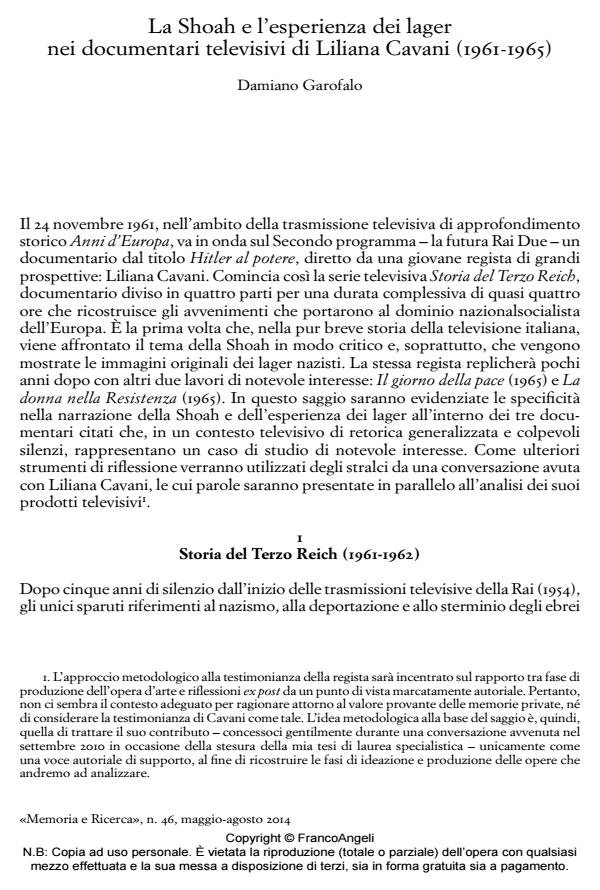La Shoah e l’esperienza dei lager nei documentari televisivi di Liliana Cavani (1961-1965)
Titolo Rivista MEMORIA E RICERCA
Autori/Curatori Damiano Garofalo
Anno di pubblicazione 2014 Fascicolo 2014/46
Lingua Italiano Numero pagine 19 P. 173-191 Dimensione file 99 KB
DOI 10.3280/MER2014-046012
Il DOI è il codice a barre della proprietà intellettuale: per saperne di più
clicca qui
Qui sotto puoi vedere in anteprima la prima pagina di questo articolo.
Se questo articolo ti interessa, lo puoi acquistare (e scaricare in formato pdf) seguendo le facili indicazioni per acquistare il download credit. Acquista Download Credits per scaricare questo Articolo in formato PDF

FrancoAngeli è membro della Publishers International Linking Association, Inc (PILA)associazione indipendente e non profit per facilitare (attraverso i servizi tecnologici implementati da CrossRef.org) l’accesso degli studiosi ai contenuti digitali nelle pubblicazioni professionali e scientifiche
Liliana Cavani is well-known as the director of the controversial Holocaust fi lm The Night Porter (1974), which inspires the birth of the new cinematographical genre of Nazisexploitation. In order to trace Cavani’s interest on the Holocaust theme we have to come back to the early 60’s, when the young director starts working for the national broadcasting television RAI. In the fi ve years between 1961 and 1965, in fact, Lilian Cavani directs three documentary fi lms: a four-episodes serie called History of the Third Reich (1961-1962); a documentary about the divided World War II memories between two generations in post-war Europe, The Day of the Peace (1965); fi nally, The Woman in the Resistance (1965), a fi lm about the role of Italian women during the Partisan struggle, where she also interviews several Jewish Italian women who were deported between 1943 and 1945. Each one of these productions has different and specifi c modalities of dealing with the Holocaust memory. But the relevance of these fi lms lays in the fact that they represent the fi rst attempt of the Italian television to deal with the memory of the Holocaust, and this happens through the screening of both audiovisual and oral sources. Until then, no previous visual expressions have described the Italian responsability in the deportation of thousands of Italian Jews. The paper is structured by using several kind of sources: audiovisual archives, production and distribution strategies, an original interview to Liliana Cavani about her early carreer.
Parole chiave:Holocaust Memory, Italian Television, Liliana Cavani, Oral History, Public Memory, Audiovisual Sources
- ‘Remember Without Hate’: The Holocaust as European Memory in 1960s’ Italian Television Emiliano Perra, in Journal of War & Culture Studies /2018 pp.223
DOI: 10.1080/17526272.2018.1490073
Damiano Garofalo, La Shoah e l’esperienza dei lager nei documentari televisivi di Liliana Cavani (1961-1965) in "MEMORIA E RICERCA " 46/2014, pp 173-191, DOI: 10.3280/MER2014-046012